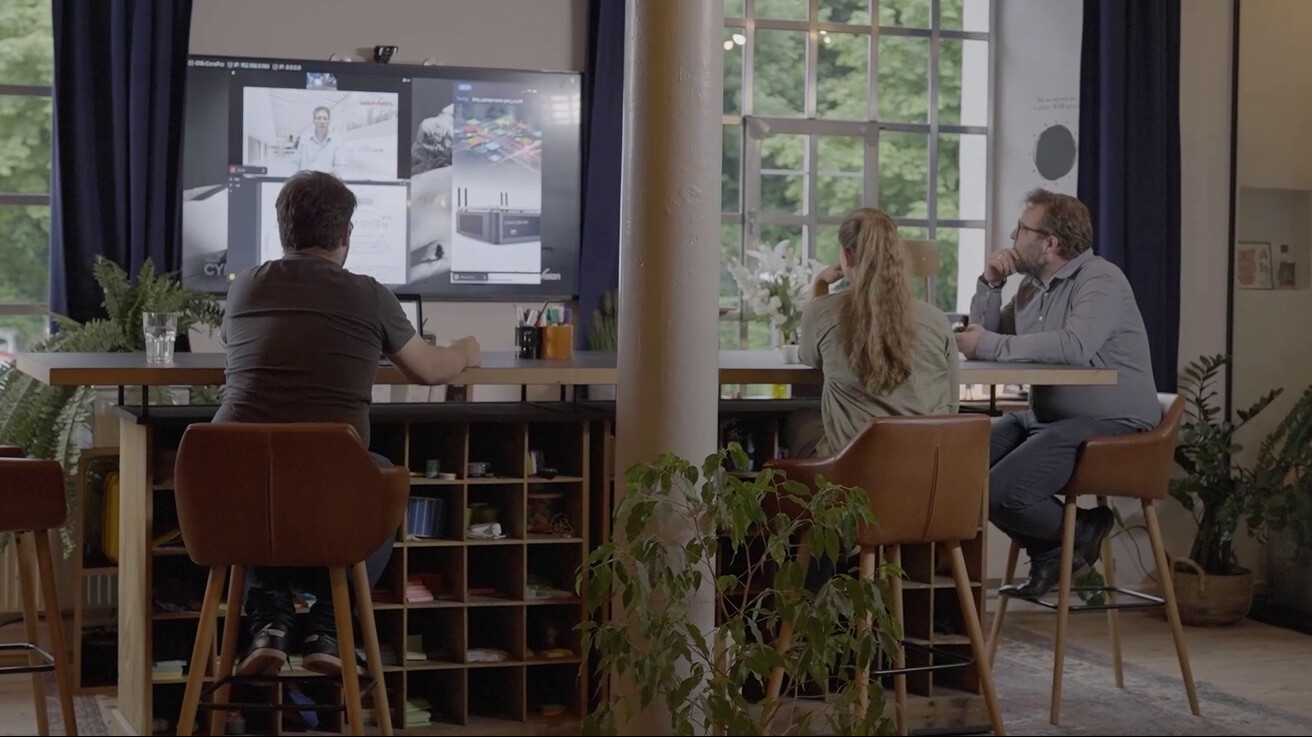Hybrid-Meeting-Ausrüstung: Besseres Arbeiten aus der Ferne, bessere Mitarbeiterbindung
What is Remote Work?
Remote work, also known as telecommuting, is the practice of employees working from a location other than the traditional office environment. This can include working from home, co-working spaces, or any location with internet access. The rise of remote work has been driven by advances in technology. It's now easier than ever before for employees to stay connected and productive from anywhere in the world.
The concept of remote work gained significant traction because of several factors. The COVID-19 pandemic forced companies worldwide to adapt quickly to remote working models to ensure business continuity while adhering to health and safety guidelines. Before the pandemic, only 20% of employed adults in the U.S. worked from home all or most of the time. This figure surged to 71% during the pandemic, with 54% expressing a desire to continue working remotely post-pandemic (Zippia) (Gomada)
Additionally, working remotely offers numerous benefits that have contributed to its popularity. Better work-life balance is often cited as the main reason for choosing remote work, with employees having more control over their schedules and saving time on commuting (Findstack). The flexibility of remote work is particularly appealing to millennials, with 69% willing to give up other benefits for a more flexible working arrangement (Findstack).
Overall, remote work has proven to be a viable and beneficial model for many organizations, providing flexibility, cost savings, and environmental benefits while maintaining or even enhancing productivity and employee satisfaction.

Why Does Remote Working Support Employee Retention?
Flexibility and Work-Life Balance: Remote work offers employees greater flexibility in managing their work schedules and personal lives. This balance is crucial for maintaining job satisfaction and reducing burnout, which directly impacts employee retention. Better work-life balance is cited as the main reason for choosing remote work, with employees having more control over their schedules and saving time on commuting (Findstack).
Increased Productivity: Many studies have shown that remote work can lead to increased productivity. Employees who have the autonomy to manage their work environment often report higher levels of efficiency and job satisfaction. For example, 77% of remote workers report higher productivity levels compared to working in an office (Findstack).
Cost Savings: Remote work can save employees money on commuting, work attire, and meals. These savings contribute to overall job satisfaction, making employees less likely to seek employment elsewhere. Employees save around $7,000 per year on transportation, food, and childcare (Findstack). Additionally, companies can save up to $11,000 per year per employee by reducing expenses related to office space, utilities, and supplies (StrongDM).
Access to a Global Talent Pool: For employers, offering remote work options can attract talent from a broader geographic area, ensuring that the best candidates are not limited by location. This flexibility makes it easier to hire high-quality talent, with 64% of recruiters saying it helps them attract top candidates (Findstack).
Environmental Impact: Remote work can reduce a company's carbon footprint, which appeals to environmentally conscious employees and can enhance a company’s corporate social responsibility profile. By reducing the need for daily commutes, remote work helps lower greenhouse gas emissions, equating to taking over 600,000 cars off the road annually (Findstack) (StrongDM).
Health and Well-Being: Remote work can significantly improve mental health and well-being. According to Gomada, 77% of employees report that remote work helps them manage their mental health conditions better. (Gomada). The flexibility to create a personalized work environment, reduced commuting stress, and a better work-life balance contribute to these positive outcomes. This improved well-being can lead to higher job satisfaction and lower turnover rates.
Professional Development and Loyalty: Remote work can provide more opportunities for professional development and continuous learning, as employees have more time and flexibility to engage in training programs. Additionally, 74% of workers say that having a remote work opportunity makes them less likely to leave a company (Findstack). Companies have experienced a 50% decrease in resignations once they started allowing employees to work remotely (Findstack).
By addressing these areas, remote work not only enhances the overall job satisfaction and productivity of employees but also strengthens their loyalty to the company, leading to improved retention rates.

What Hybrid Meeting Equipment Is Available?
Hybrid meetings, which include both in-person and remote participants, require specific equipment to ensure a seamless experience for all attendees.
Video Conferencing Systems: High-quality systems are essential for clear and uninterrupted communication, ranging from basic setups with webcams and microphones to advanced solutions with integrated collaboration tools.
Web Conferencing: Browser-based solutions like Zoom or Microsoft Teams are suitable for large meetings, webinars, and casual team meetings. BYOM (Bring Your Own Meeting) allows users to connect their laptops to in-room peripherals, combining personal device convenience with professional meeting room equipment like microphones, speakers, and cameras.
Dedicated Team Rooms/Zoom Rooms: These specialized setups integrate hardware and software for an optimized meeting environment, often including high-definition cameras, advanced microphones, and interactive displays.
Other In-Room Equipment: This includes video bars (integrated camera, microphone, and speaker systems), standalone PTZ cameras, and advanced audio systems to enhance the meeting experience.
High-Resolution Cameras: Ensure remote participants can clearly see the speaker and shared materials. PTZ capabilities provide flexibility in framing different participants and viewpoints.
Audio Systems: Clear audio is critical. Noise-canceling microphones and speakers that provide clear sound throughout the room are essential, whether through integrated systems or standalone setups.
Interactive Displays: Enable participants to engage with content in real-time. Touchscreen displays facilitate collaborative activities such as brainstorming sessions and presentations.
Document Cameras: Allow presenters to share physical documents, 3D objects, and detailed images with all participants, enhancing understanding and engagement.
Collaboration Software: Robust software that integrates with your video conferencing system is crucial. Look for features like screen sharing, real-time editing, and easy access to shared files and documents.
Reliable Internet Connection: A stable, high-speed connection is vital for preventing disruptions. Ensure that both in-office and remote participants have access to reliable internet.
By integrating these elements, hybrid meetings can offer a seamless and engaging experience for all participants.

Conclusion
Investing in high-quality hybrid meeting equipment is not just about enhancing communication and collaboration; it’s about creating a work environment that supports flexibility, inclusivity, and professional growth. By providing the tools necessary for effective hybrid meetings, companies can improve employee satisfaction and retention, ultimately leading to a more productive and engaged workforce.
Remember also that a lot of in-room meetings are also still taking place. Remote teams are still convening in the office for face-to-face interaction, so your equipment must also be able to support high quality in-person meetings. Your collaboration tools are vitally important to ensure collaborative equity for teams wherever they are located.
WolfVision’s award-winning Cynap wireless presentation, web conferencing and collaboration solutions are used by many of the world's leading organisations to support remote working patterns. Contact us now to find out more.
